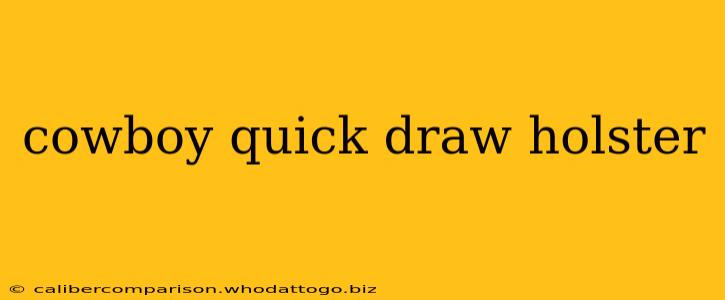The Wild West's romanticized image often features a gunslinger's lightning-fast draw. Central to this iconic scene is the quick draw holster, a piece of equipment demanding both precision engineering and a deep understanding of its user. This guide delves into the world of cowboy quick draw holsters, exploring their history, design features, materials, and considerations for choosing the right one.
A Brief History of the Quick Draw Holster
Long before the Hollywood portrayal, quick draw holsters were functional tools essential for survival in the American frontier. Early designs were often rudimentary, utilizing readily available materials like leather and wood. However, as the need for speed and reliability increased, so did the sophistication of holster design. Innovations in tooling and materials led to the development of custom-fitted holsters optimized for specific firearms and drawing styles. The evolution continues today, with modern holsters incorporating advancements in materials science and ergonomic design.
Key Features of a Quality Quick Draw Holster
Several key features distinguish a high-quality quick draw holster from an inferior one. These features directly impact draw speed, weapon security, and overall comfort:
1. Material and Construction:
- Leather: Traditional and popular, high-quality leather offers durability, comfort, and a natural molding ability that conforms to the firearm over time. Full-grain leather is preferred for its strength and longevity.
- Kydex: A modern, thermoplastic polymer, Kydex offers exceptional durability, water resistance, and a precise fit for the firearm. It's known for its fast draw and retention capabilities.
- Hybrid designs: Combine the best aspects of both leather and Kydex, often incorporating leather for comfort and Kydex for retention and rigidity.
2. Retention:
A secure retention system is critical. This prevents accidental discharges and ensures the firearm stays in place during strenuous activities. Features like thumb breaks, snaps, or straps provide varying levels of retention.
3. Draw Angle and Cant:
The holster's angle (cant) and draw angle significantly affect draw speed and comfort. Experimentation is key to finding the ideal angle for your body type and shooting style.
4. Fit and Finish:
A well-made holster fits the firearm snugly, preventing movement and ensuring a smooth, consistent draw. Look for precise stitching, reinforced stress points, and an overall clean finish.
Choosing the Right Quick Draw Holster: Considerations for Users
Selecting the right quick draw holster depends heavily on individual needs and preferences. Here are some key considerations:
- Firearm type: The holster must be specifically designed for your firearm's make and model.
- Intended use: A holster for competition will differ significantly from one used for historical reenactment or concealed carry.
- Body type and build: The holster should be comfortable and allow for a natural and efficient draw.
- Budget: Prices range considerably, depending on materials, features, and customization.
Maintenance and Care of Your Quick Draw Holster
Proper care ensures the longevity and effectiveness of your holster. Regular cleaning and conditioning (for leather holsters) will prevent wear and tear and maintain its structural integrity. Kydex holsters require less maintenance but should be kept clean to prevent the buildup of dirt and debris.
Conclusion: Beyond the Romanticized Image
The cowboy quick draw holster is more than just a nostalgic accessory; it's a precision tool that demands careful consideration. By understanding the historical context, design features, and individual needs, you can choose a holster that enhances your safety, performance, and appreciation for this iconic piece of Western history. Remember to always practice safe firearm handling techniques, regardless of the type of holster used.

